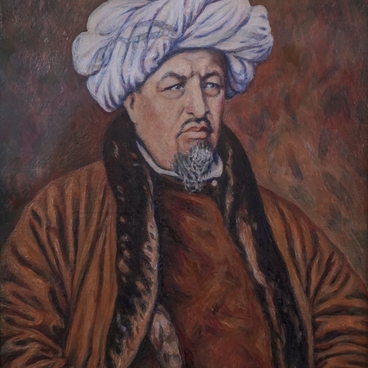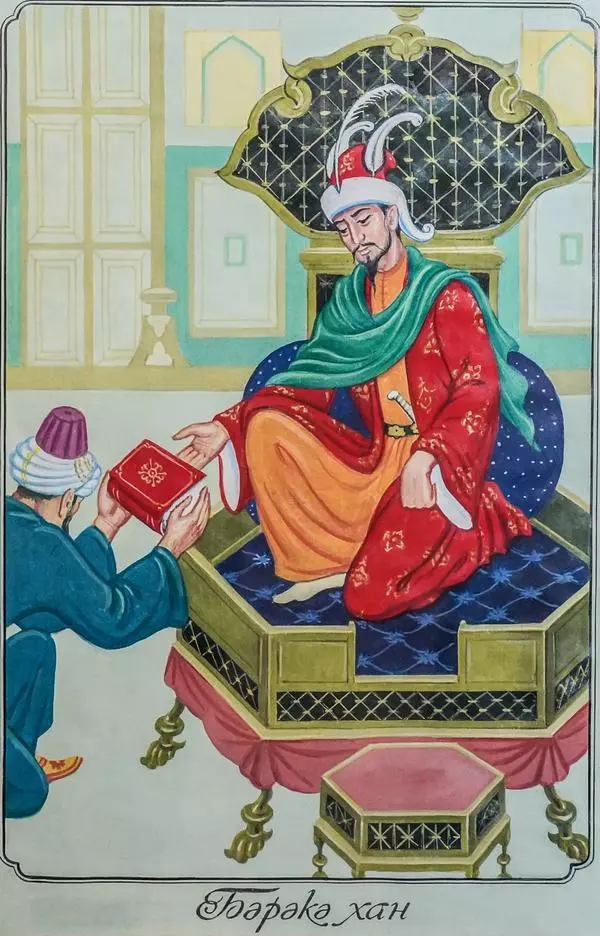The portrait features Muhammedyar, a scientist and poet of the Kazan Khanate period. He is holding a book and a pen in his hands, as if he is ready to write down new poetry lines any time. The poet’s noble attire is made in blue tones. In the upper right corner there is a poetic quote starting with the words “Do good…” The Kazan Kremlin is seen in the background.
Muhammedyar Mahmud Hadji uly was the son of Mahmud Hadji, a Tatar poet of the first half of the 16th century. He lived and created his masterpieces in a difficult period, during the reign of Khan Safa Giray. The Kazan Khanate was a feudal state, where khans of Crimean dynasties robbed and abused common people. Safa Giray supported them using mass repressions to fight rare rebels. Internecine wars among feudal lords, hostility on the part of the neighbors, recurrent territorial conflicts left an indelible mark on the poet’s life.
It is no wonder that Muhammedyar preached sympathy and love for common people, demanded justice from the rulers. He believed in life and proceeded in his aspirations from the principles of honest and faithful service to people, kindness, love for the weak, humiliated and insulted.
‘Thanks to justice, prosperity will come to the country, unrest and oppression will disappear forever’ are famous lines from Muhammedyar’s poem. The following words also reflect how kind-hearted and sincere he was towards people: “Do good, as kindness is the essence of everything, whoever evil will meet with retribution.”
He often used allegories in his works, as it was customary at the time. In one of his stories, a girl turns into a wolf and devours the Shah’s daughter. Using animal images and hints, the poet criticized the ruling elite, threatened evil and greedy rulers with punishments in the afterlife world. God acts in his stories as a defender of common people, the weak and the destitute.
His poems The Men’s Gift (1539-1540) and The Light of Hearts (1542) were an important milestone in the development of Tatar literature. He was not the only Kazan poet at the time, but he stood out from other poets for his remarkable talent and secular nature of his works. He died in 1547 in Murom.
Interest in Muhammedyar’s oeuvre was revived by Tatar scientist Naki Isanbet, who published an article about his work in 1941. Muhammedyar was featured prominently in 1956 Anthology of Tatar Poetry.
Muhammedyar Mahmud Hadji uly was the son of Mahmud Hadji, a Tatar poet of the first half of the 16th century. He lived and created his masterpieces in a difficult period, during the reign of Khan Safa Giray. The Kazan Khanate was a feudal state, where khans of Crimean dynasties robbed and abused common people. Safa Giray supported them using mass repressions to fight rare rebels. Internecine wars among feudal lords, hostility on the part of the neighbors, recurrent territorial conflicts left an indelible mark on the poet’s life.
It is no wonder that Muhammedyar preached sympathy and love for common people, demanded justice from the rulers. He believed in life and proceeded in his aspirations from the principles of honest and faithful service to people, kindness, love for the weak, humiliated and insulted.
‘Thanks to justice, prosperity will come to the country, unrest and oppression will disappear forever’ are famous lines from Muhammedyar’s poem. The following words also reflect how kind-hearted and sincere he was towards people: “Do good, as kindness is the essence of everything, whoever evil will meet with retribution.”
He often used allegories in his works, as it was customary at the time. In one of his stories, a girl turns into a wolf and devours the Shah’s daughter. Using animal images and hints, the poet criticized the ruling elite, threatened evil and greedy rulers with punishments in the afterlife world. God acts in his stories as a defender of common people, the weak and the destitute.
His poems The Men’s Gift (1539-1540) and The Light of Hearts (1542) were an important milestone in the development of Tatar literature. He was not the only Kazan poet at the time, but he stood out from other poets for his remarkable talent and secular nature of his works. He died in 1547 in Murom.
Interest in Muhammedyar’s oeuvre was revived by Tatar scientist Naki Isanbet, who published an article about his work in 1941. Muhammedyar was featured prominently in 1956 Anthology of Tatar Poetry.
Scientist and researcher of ancient Tatar literature, Abilov wrote about the poet as follows: ‘Muhammedyar’s language is the literary language of Kazan Tatars of the first half of the 16th century.’
The author of the painting Rushan Shamsutdinov is a famous Kazan painter, graphic artist, calligrapher, member of the Artists’ Union of the Russian Federation and the Artists’ Union of the Republic of Tatarstan.
The author of the painting Rushan Shamsutdinov is a famous Kazan painter, graphic artist, calligrapher, member of the Artists’ Union of the Russian Federation and the Artists’ Union of the Republic of Tatarstan.



